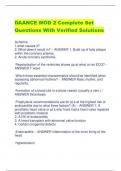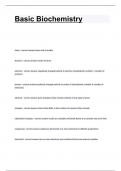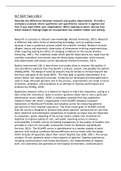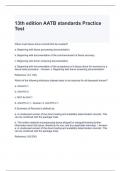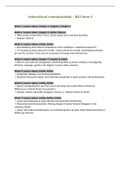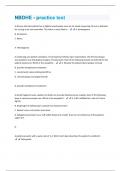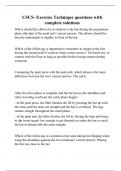IMAGING:
principles and methodology
Samenvatting
Rosanne
,Inhoud
1 Introduction ............................................................................................................................................................... 5
1.1 Little overview .................................................................................................................................................. 5
1.2 Introduction ....................................................................................................................................................... 5
1.2.1 Brain enthusiasm: The relevance of distinguishing fact from fiction ....................................................... 5
1.3 The basis of neural signals ................................................................................................................................ 7
1.3.1 Information Transfer in Neurons .............................................................................................................. 7
1.3.2 Signal processing ...................................................................................................................................... 8
Some concepts....................................................................................................................................................... 8
1.3.3 Molecular and hemodynamic signals ...................................................................................................... 10
Energy consumption ........................................................................................................................................... 10
Clustering ............................................................................................................................................................ 10
1.3.4 A short overview of methods in human neuroscience ............................................................................ 11
Measuring brain structure ................................................................................................................................... 11
Measuring hemodynamics .................................................................................................................................. 12
Measuring electrophysiological activity ............................................................................................................. 12
Example .............................................................................................................................................................. 12
2 Structural neuroimaging (ch2); the physics behind MRI ........................................................................................ 13
2.1 The effect of the magnetic fields on the human body ..................................................................................... 13
2.1.1 Magnetic field effect ............................................................................................................................... 13
2.1.2 Gradients ................................................................................................................................................. 14
Gradients of field strength................................................................................................................................... 14
A. Slice selection gradient ........................................................................................................................... 14
B. Phase encoding gradient ......................................................................................................................... 15
C. Frequency encoding gradient ................................................................................................................. 15
Pulse sequences ................................................................................................................................................... 15
Creating a spatial image from the signal ............................................................................................................. 16
2.1.3 Fourier analysis ....................................................................................................................................... 16
2.2 How do these physical principles give rise to an image with anatomical structure? ...................................... 17
2.2.1 T1 recover and T2 decay ......................................................................................................................... 18
2.2.2 Weighted contrasts .................................................................................................................................. 18
2.3 The hardware of scanner ................................................................................................................................. 19
2.4 Parameters which are chosen by the user ........................................................................................................ 19
3 Structural neuroimaging (ch3) ................................................................................................................................ 19
3.1 Structural T1-weighted MRI ........................................................................................................................... 19
3.1.1 Normalization.......................................................................................................................................... 19
Volume-based normalization .............................................................................................................................. 20
Segmentation-based normalization ..................................................................................................................... 20
Surface-based normalization ............................................................................................................................... 20
3.1.2 Cortical surface and voxels ..................................................................................................................... 21
1
, 3.1.3 Morphometry & VLSM .......................................................................................................................... 21
3.2 Different tensor imaging (DTI) ....................................................................................................................... 22
3.2.1 Diffusion-weighted imaging (DWI) ........................................................................................................ 22
3.2.2 Data analysis ........................................................................................................................................... 23
3.2.3 Interpretation ........................................................................................................................................... 24
4 Hemodynamic neuroimaging .................................................................................................................................. 25
4.1 Introduction ..................................................................................................................................................... 25
4.2 Hemodynamics and its relationship to neural activity .................................................................................... 25
4.2.1 3 components of HRF & measurement ................................................................................................... 26
4.2.2 Neural activity and HR ........................................................................................................................... 26
4.3 Functional magnetic resonance imaging (fMRI) ............................................................................................ 27
4.3.1 GE EPI .................................................................................................................................................... 28
4.3.2 Relavence of fMRI .................................................................................................................................. 29
4.4 Positron Emission Tomography (PET) ........................................................................................................... 29
4.4.1 PET to measure neural activity ............................................................................................................... 29
4.4.2 PET versus fMRI .................................................................................................................................... 30
4.4.3 Unique contribution of PET .................................................................................................................... 30
4.5 Functional Near InfraRed Spectroscopy (fNIRS) .......................................................................................... 30
4.5.1 (Dis)advantages of fNIRS compared to fMRI ........................................................................................ 31
4.6 A comparison of research with fMRI, PET, and fNIRS ................................................................................. 31
5 Designing a hemodynamic imaging experiment ..................................................................................................... 32
5.1 Think before you start an experiment ............................................................................................................. 32
5.2 Which conditions to include: The subtraction method ................................................................................... 32
5.3 How to present the conditions ......................................................................................................................... 33
5.3.1 Block design............................................................................................................................................ 33
5.3.2 The event-related design ......................................................................................................................... 34
5.4 The baseline or rest condition ......................................................................................................................... 35
5.5 Task and stimuli in the scanner ....................................................................................................................... 36
6 Hemodynamic imaging (Ch 6): image processing .................................................................................................. 37
6.1 Role of image pre-processing ......................................................................................................................... 37
6.2 Properties of the images .................................................................................................................................. 37
6.2.1 4D fMRI data .......................................................................................................................................... 38
6.2.2 Preprocessing: the steps .......................................................................................................................... 38
Step 0: Quality control ........................................................................................................................................ 38
6.2.3 Step 1: slice timing .................................................................................................................................. 39
6.2.4 Step 2: Motion correction ....................................................................................................................... 39
6.2.5 Step 3: Co-registration ............................................................................................................................ 40
6.2.6 Step 4: Normalization ............................................................................................................................. 41
6.2.7 Step 5: spatial smoothing ........................................................................................................................ 41
7 Hemodyamic imaging (Ch7): basis statistical analyses ......................................................................................... 43
2
, 7.1 Statistical analyses: The general linear model ................................................................................................ 43
7.1.1 Simple linear regression .......................................................................................................................... 43
7.1.2 Multiple linear regression ....................................................................................................................... 43
7.1.3 GLM for fMRI ........................................................................................................................................ 44
Regressors of interest .......................................................................................................................................... 44
Clean your data & whitening .............................................................................................................................. 45
Efficiency of the design ...................................................................................................................................... 46
7.2 Determining significance and interpreting it................................................................................................... 47
7.2.1 Assumptions or assumptions ................................................................................................................... 47
7.2.2 Multiple comparisons .............................................................................................................................. 48
7.2.3 Second-level whole-brain analyses and ROI analysis............................................................................. 49
Whole brain ......................................................................................................................................................... 49
ROI ...................................................................................................................................................................... 49
7.2.4 Interference ............................................................................................................................................. 51
8 Hemodynamic Imaging (Ch 8): Advanced statistical analyses ............................................................................... 52
8.1 Functional connectivity ................................................................................................................................... 52
8.1.1 Designs and analyses .............................................................................................................................. 52
Caveats: time scale, correlation, subject motion ................................................................................................. 52
8.1.2 Modeling directional functional connectivity ......................................................................................... 54
8.1.3 Functional vs anatomical connectivity .................................................................................................... 55
8.1.4 Resting state fMRI .................................................................................................................................. 56
8.2 Multi-voxel pattern analyses (MVPA) ............................................................................................................ 56
8.2.1 ROI vs whole brain ................................................................................................................................. 57
8.2.2 The potential ........................................................................................................................................... 58
8.2.3 What do we measure? ............................................................................................................................. 59
8.3 Functional MRI adaption ................................................................................................................................ 60
9 Electromagnetic field of the brain ........................................................................................................................... 61
9.1 Electrophysiological activity of the brain ....................................................................................................... 61
9.1.1 From neurons to electromagnetic field ................................................................................................... 61
9.2 Electromagnetic field signals .......................................................................................................................... 62
9.2.1 Properties of the field signal ................................................................................................................... 62
9.2.2 Dimensions and resolution of the field signal ......................................................................................... 63
Spatial resolution................................................................................................................................................. 63
9.3 Brain dynamics vs. mind dynamics ................................................................................................................ 64
10 Electroencephalography and magnetoencephalography ..................................................................................... 65
10.1 Electroencephalography (EEG) ...................................................................................................................... 65
10.1.1 Electrodes ................................................................................................................................................ 65
10.1.2 Amplifier ................................................................................................................................................ 66
10.2 EEG summary ................................................................................................................................................. 66
10.3 Magnetoencephalography (MEG) ................................................................................................................... 67
3


